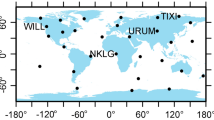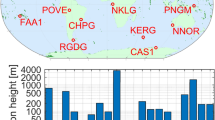Abstract
For high-accuracy geodetic applications, time-variable tropospheric propagation delay errors limit global positioning system real-time kinematic positioning accuracy. Potential improvements in positioning accuracy are evaluated by using the National Oceanic and Atmospheric Administration (NOAA) real-time tropospheric corrections (herein called NOAA model) within a multiple reference station network approach. The results are compared with those for modified Hopfield tropospheric model corrections, for six scenarios in three geographical regions in the U.S. National Geodetic Survey network of Continuously Operating Reference Stations, for baseline lengths of 60~150 km. Analyses are conducted at rover locations for relatively humid days, and misclosures for various double difference observations are computed; these observations include each frequency (L1 and L2) and three linear combinations [wide lane, ionosphere free (IF), and geometry free]. The effectiveness of the network approach is demonstrated, with overall performance improvements of 15 and 19%, using the modified Hopfield and the NOAA model, respectively. The IF linear combination, a measure of tropospheric and orbital errors, shows a 3% improvement for the NOAA model compared with the modified Hopfield model.













Similar content being viewed by others
References
Ahn YW, Kim D, Dare P, Langley RB (2005) Long baseline GPS RTK performance in a marine environment using NWP ray-tracing technique under varying tropospheric conditions. In: Proceeding of ION GNSS 2005, Long Beach (in press)
Alves P, Ahn YW, Lachapelle G (2003) The effects of network geometry on network RTK using simulated GPS data. In: Proceeding of ION GPS 2003. Portland, pp 1417–1427
Alves P, Ahn YW, Liu J, Lachapelle G, Wolfe D, Cleveland A (2004) Improvements of USCG RTK positioning performance using external NOAA tropospheric corrections integrated with a multiple reference station approach. In: Proceedings of ION NTM 2004, San Diego, pp 689–698
Behrend D, Cucurull L, Cardellach E, Rius A, Sedo MJ, Nothnagel A (2001) The use of NWP products in near real-time GPS data processing. In: Proceedings of ION GPS 2001, Salt Lake City, pp 2499–2506
Bisnath SB, Dodd D, Cleveland A, Parsons M (2004) Analysis of the utility of NOAA-generated tropospheric refraction corrections for the next generation nationwide DGPS service. In: Proceeding of ION GNSS 2004, Long Beach, pp 1288–1297
Brevis M, Brusinger S, Herring TA, Rocken C, Anthes RA, Ware RH (1992) GPS meteorology: remote sensing of atmospheric water vapor using the global positioning system. J Geophys Res 97(D14):15787–15801
Cannon ME, Lachapelle G, Alves P, Fortes LP, Townsend B (2001) GPS RTK positioning using a regional reference network: theory and results. In: Proceedings of the 5th GNSS international symposium, Seville
Cannon ME, Lachapelle G, Ahn YW, Alves P, Lian P, Liu J, Morton A, Petovello M, Schleppe J (2004) Improving the existing USCG DGPS service: analysis of potential system upgrades and their effect on accuracy, reliability and integrity. Technical Report prepared for the United States Coast Guard, Portsmouth
Chen R, Li X, Weber G (2004) Test results of an Internet RTK system based on the NTRIP protocol. The European GNSS 2004, Rotterdam
Cove K (2005) Improvements in GPS tropospheric delay estimation with numerical weather prediction. MScE Thesis, Department of Geodesy and Geomatics Engineering, University of New Brunswick
Cove K, Santos MC, Wells D, Bisnah S (2004) Improved tropospheric delay estimation for long baseline, carrier phase differential GPS positioning in a coastal environment. In: Proceeding of ION GNSS 2004, Long Beach, pp 925–932
Elgered G (1993) Tropospheric radio-path delay from ground-based microwave-radiometry. In: Janssen MA (ed) Atmospheric remote sensing by microwave radiometry. Wiley, New York, pp 215–258
Fortes LP, Cannon ME, Skone S, Lachapelle G (2001) Improving a multi-reference GPS station network method for OTF positioning in the St. Lawrence Seaway. In: Proceedings of ION GPS 2001, Salt Lake City, pp 404–414
Fotopoulos G, Cannon M (2000) Investigation of the spatial decorrelation of GPS carrier phase errors using a regional reference station network. In: Proceedings of the World Congress of International Association, San Diego
Goad CC, Goodman L (1974) A modified Hopfield tropospheric refraction correction model. The American Geophysical Union, San Francisco, pp 28
Grejner-Brzezinska DA, Kashani I, Wielgosz P (2004) Analysis of the network geometry and station separation for network-based RTK. In: Proceeding of ION NTM 2004, San Diego, pp 469–474
Gutman SI, Benjamin SG (2001) The role of ground-based GPS meteorological observations in numerical weather prediction. GPS Solutions 4(4):16–24
Gutman S, Fuller-Rowell T, Robinson D (2003) Using NOAA atmospheric models to improve ionospheric and tropospheric corrections. U.S. Coast Guard differential GPS symposium, Portsmouth. http://www.gpsmet.noaa.gov/jsp/downloads/NOAA_Atmospheric_Corrections.ppt
Jensen ABO (2002) Numerical weather prediction for network RTK. PhD Thesis, University of Copenhagen, Publication Series 4, vol 10, National Survey and Cadastre, Denmark
Kashani I, Grejner-Brzezinska DA, Wielgosz P (2004) Towards instantaneous network-based RTK GPS over 100 km distances. In: Proceeding of ION 60th annual meeting, Dayton, pp 679–685
Kim D, Langley RB, Kim JH, Kim SN (2003) A gantry crane auto-steering system based on GPS RTK technology. The European GNSS 2003, Graz
Lachapelle G, Townsend B, Alves P, Fortes LP, Cannon ME (2000) RTK positioning using a reference network. In: Proceedings of ION GPS 2000, Alexandria, pp 1165–1171
Landau H, Vollath U, Chen X (2003) Virtual reference stations versus broadcast solutions in network RTK: advantages and limitations. The European GNSS 2003, Graz
NOAA (2001) NOAA/FSL ground-based GPS integrated precipitable water vapor real time water vapor interface. http://www.gpsmet.noaa.gov
NOAA (2004) NOAA/FSL ground-based GPS meteorology (GPS-Met). http://gpsmet2.fsl.noaa.gov/
Niell AE (1996) Global mapping functions for the atmosphere delay at radio wavelengths. J Geophys Res 101(B2):3227–3246
Nievinski F, Cover K, Santos M, Wells D, Kingdon R (2005) Range-extended GPS kinematic positioning using numerical weather prediction model. In: Proceedings of ION annual meeting, Boston (in press)
Odijk D (1999) Stochastic modelling of the ionosphere for fast GPS ambiguity resolution. In: Proceedings of the general assembly of the international association of geodesy, Birmingham, England, International Association of Geodesy, Springer, Berlin Heidelberg New York, vol 121, pp 387–392
Pany T, Pesec P, Stangl G (2001) Elimination of tropospheric path delays in GPS observations with the ECMWF numerical weather model. Phys Chem Earth A 26(6–8):487–492
Raquet J (1998) Development of a method for kinematic GPS carrier-phase ambiguity resolution using multiple reference receivers. PhD Thesis, UCGE Report Number 20116, University of Calgary
Raquet J, Lachapelle G (2000) Development and testing of a kinematic carrier-phase ambiguity resolution method using a reference receiver network. The Institute of Navigation, Alexandria, vol 46, no. 4, pp 283–295
Raquet J, Lachapelle G, Melgard TE (1998) Test of a 400 km×600 km network of reference receivers for precise kinematic carrier-phase positioning in Norway. In: Proceedings of ION NTM 1998, Nashville, pp 407–416
Rizos C (2002) Network RTK research and implementation: a geodetic perspective. J Glob Position Syst 1(2):144–150
Rocken C, Mervart L, Lukes Z, Johnson J, Kanzaki M, Kakimoto H, Iotake Y (2004) Testing a new network RTK software system. In: Proceeding of ION GNSS 2004, Long Beach, pp 2831–2838
Rothacher M, Beutler G (2002) Advanced aspects of satellite positioning. Lecture notes of ENGO 699.80, University of Calgary
Schuler T (2001) On ground-based GPS tropospheric delay estimation. PhD Thesis, University of Munchen
Talbot N, Lu G, Allison T (2002) Broadcast network RTK—transmission standards and results. In: Proceedings of the 15th international technical meeting, Portland, Oregon
Thayer GD (1974) An improved equation for the radio refractive index of air. Radio Sci 9(10):803–807
Wanninger L (1999) The performance of virtual reference stations in active geodetic GPS-networks under solar maximum conditions. In: Proceeding of ION GPS 1999, Nashville, pp 1419–1427
Zhang J (1999) Investigation into the estimation of residual tropospheric delays in a GPS network. MSc Thesis, University of Calgary
Zhang Y, Barton C (2005) Comparison of real-time troposphere correction techniques for high performance DGPS application. In: Proceeding of ION NTM 2005, San Diego, pp 666–684
Author information
Authors and Affiliations
Corresponding author
Rights and permissions
About this article
Cite this article
Ahn, Y.W., Lachapelle, G., Skone, S. et al. Analysis of GPS RTK performance using external NOAA tropospheric corrections integrated with a multiple reference station approach. GPS Solut 10, 171–186 (2006). https://doi.org/10.1007/s10291-005-0017-1
Received:
Accepted:
Published:
Issue Date:
DOI: https://doi.org/10.1007/s10291-005-0017-1




